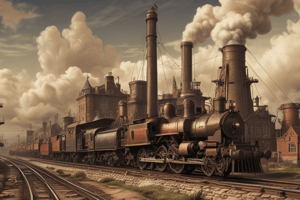Podcast
Questions and Answers
শিল্প বিপ্লবের কারণ হিসেবে কোনটি গুরুত্বপূর্ণ ছিল?
শিল্প বিপ্লবের কারণ হিসেবে কোনটি গুরুত্বপূর্ণ ছিল?
- খাদ্য উৎপাদনের অভাব
- মেশিনারির আবিষ্কার
- শিল্প উৎপাদনের বৃদ্ধি (correct)
- রাসায়নিক উৎপাদনের বৃদ্ধি
শিল্প বিপ্লবের প্রধান ফলাফল ছিল
শিল্প বিপ্লবের প্রধান ফলাফল ছিল
- শিল্প উৎপাদনে বৃদ্ধি (correct)
- নতুন পরিশ্রমিক চাকরির সৃষ্টি
- খাদ্যের উন্নতি
- বাড়তি আয়ের অভিজ্ঞতা
নীচের 5. Invention of Machinery-রা
নীচের 5. Invention of Machinery-রা
- না-Авilability of Raw Materials**-रা, 5. **Invention of Machinery**-रা।
- **Agricultural Revolution**-रা, 5. **Invention of Machinery**-रा। (correct)
- **Increased Demand for Goods**-रा, 5. **Invention of Machinery**-रा।
- না-না, 5. **Invention of Machinery**-रা ।
শিল্প বিপ্লবের জন্য মেরামতের 5. Avilability of Raw Materials-রা
শিল্প বিপ্লবের জন্য মেরামতের 5. Avilability of Raw Materials-রা
শিল্প বিপ্লবের প্রভাবের মধ্যে বিশেষভাবে বিশেষভাবে কোনটি প্রধান?
শিল্প বিপ্লবের প্রভাবের মধ্যে বিশেষভাবে বিশেষভাবে কোনটি প্রধান?
শিল্প বিপ্লবের জন্য নির্মিত 'অরুদ্ধ' কোন উদাহরণ?
শিল্প বিপ্লবের জন্য নির্মিত 'অরুদ্ধ' কোন উদাহরণ?
শিল্প বিপ্লবের ফলে নগরীকরণের প্রাথমিক ফলাফল কী?
শিল্প বিপ্লবের ফলে নগরীকরণের প্রাথমিক ফলাফল কী?
নির্মাণ উৎ্্্্্্্া্াাা্াাা্্াা্াা্াাà ্াাাà�ো�্�্�ো�্�àààààààààààààà্�্�্�্�্�্�àààààাা��নি: 4(7+3)।
নির্মাণ উৎ্্্্্্্া্াাা্াাা্্াা্াা্াাà ্াাাà�ো�্�্�ো�্�àààààààààààààà্�্�্�্�্�্�àààààাা��নি: 4(7+3)।
'James Watt' -র 'নিউকোমেন' ভাপ ইঞ্জিনের 'নির্মাণ' -fixing -r'
'James Watt' -র 'নিউকোমেন' ভাপ ইঞ্জিনের 'নির্মাণ' -fixing -r'
'James Watt' -র 'নি: 2(8+3)'।
'James Watt' -র 'নি: 2(8+3)'।
Flashcards are hidden until you start studying
Study Notes
IDC History Semester 1: Industrial Revolution
The Industrial Revolution marked the beginning of the second era of the Industrial Age. It was a period of significant change in the manufacturing industry, characterized by the transition from hand production to mechanized production and the development of the factory system. This article provides an overview of the Industrial Revolution, focusing on its causes, impacts, and key figures.
Causes of the Industrial Revolution
The Industrial Revolution was triggered by a combination of factors, including:
-
Agricultural Revolution: The growth of agriculture led to an increase in food production, which in turn led to an increase in the population. This provided a large labor force for the factories that were being established.
-
Increased Demand for Goods: The growing population created a significant increase in the demand for goods. This demand led to the expansion of manufacturing industries and the development of new industries.
-
Availability of Raw Materials: The availability of raw materials, such as coal, iron, and water, played a crucial role in the Industrial Revolution. These materials were essential for the production of textiles, iron, and other goods.
-
Invention of Machinery: The invention of new machines and the improvement of existing ones facilitated the mechanization of production processes. This led to increased efficiency and productivity in the manufacturing industries.
-
Increase in Capital: The increase in capital available for investment in manufacturing industries played a significant role in the Industrial Revolution. This capital was used to build factories, purchase machinery, and hire workers.
Impacts of the Industrial Revolution
The Industrial Revolution had a profound impact on society and the economy. Some of the key impacts include:
-
Urbanization: The establishment of factories led to the growth of cities and the development of urban areas. This led to the creation of new jobs and the migration of people from rural areas to urban areas.
-
Improved Living Standards: The Industrial Revolution led to an improvement in living standards for many people. This was due to the increased availability of goods and services, as well as the creation of new jobs.
-
Increased Productivity: The mechanization of production processes led to increased productivity in the manufacturing industries. This allowed for the production of goods on a larger scale and at a faster rate.
-
Environmental Impact: The Industrial Revolution had a significant impact on the environment, with the increased production of goods leading to increased pollution and resource depletion.
Key Figures of the Industrial Revolution
Some of the key figures associated with the Industrial Revolution include:
-
James Watt: Watt was a Scottish inventor and mechanical engineer who is best known for his improvements to the Newcomen steam engine. His inventions played a significant role in the mechanization of production processes.
-
Robert Crompton: Crompton was an English inventor who is credited with inventing the electric motor. His invention played a significant role in the development of the electrical industry.
-
Andrew Carnegie: Carnegie was an American industrialist and philanthropist who played a significant role in the development of the steel industry. He was also a major philanthropist, donating large sums of money to various causes.
-
John D. Rockefeller: Rockefeller was an American industrialist and philanthropist who played a significant role in the development of the oil industry. He was also a major philanthropist, donating large sums of money to various causes.
In conclusion, the Industrial Revolution marked a significant turning point in the history of the manufacturing industry. It was a period of significant change, characterized by the transition from hand production to mechanized production and the development of the factory system. The Industrial Revolution had a profound impact on society and the economy, with key figures such as Watt, Crompton, Carnegie, and Rockefeller playing significant roles in its development.
Studying That Suits You
Use AI to generate personalized quizzes and flashcards to suit your learning preferences.




